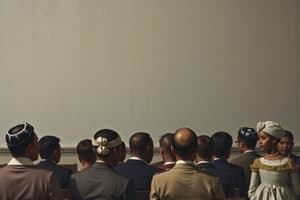Podcast
Questions and Answers
The argument of 'separate but equal' was considered valid by the US Supreme Court during the Brown vs Board of Education case.
The argument of 'separate but equal' was considered valid by the US Supreme Court during the Brown vs Board of Education case.
False (B)
Oliver Brown was the main plaintiff in the Brown vs Board of Education case.
Oliver Brown was the main plaintiff in the Brown vs Board of Education case.
True (A)
The schools for black students in Topeka, Kansas, had better facilities than those for white students.
The schools for black students in Topeka, Kansas, had better facilities than those for white students.
False (B)
Resistance to the Supreme Court's ruling occurred mainly in the northern United States.
Resistance to the Supreme Court's ruling occurred mainly in the northern United States.
The ruling in Brown vs Board of Education occurred in 1954.
The ruling in Brown vs Board of Education occurred in 1954.
Flashcards
Brown v. Board of Education
Brown v. Board of Education
The Supreme Court case that ended legal racial segregation in public schools in the United States.
Separate but Equal
Separate but Equal
A legal doctrine used to justify racial segregation, claiming that separate facilities for different races could be equal if they offered similar resources. This doctrine was ultimately found to be unconstitutional by the Supreme Court.
Class Action Lawsuit
Class Action Lawsuit
A legal strategy where a group of people with similar legal issues collectively sue a defendant, often a government agency or institution, in order to achieve a broader social change. It was the strategy used in Brown v. Board of Education.
Civil Rights
Civil Rights
Signup and view all the flashcards
Enforcement
Enforcement
Signup and view all the flashcards
Study Notes
Segregation in US Schools
- Schools in the southern US were segregated, with separate facilities for black and white students.
- Black students faced significantly worse learning conditions than white students, including inferior classrooms, teachers, and resources.
- These unequal conditions negatively impacted black students' education and mental well-being.
- Despite being illegal under the US Constitution, segregation was defended using the "separate but equal" justification.
- This justification, however, was proven false in practice, as segregated facilities were demonstrably unequal.
Brown vs. Board of Education
- In 1951, Oliver Brown, and 12 others, filed a class action lawsuit against the Board of Education in Topeka Kansas.
- The lawsuit challenged the "separate but equal" doctrine, asserting that separate facilities for black and white students were actually unequal in practice, harming black students' education and well-being.
- On May 17, 1954, the Supreme Court ruled that separate educational facilities were inherently unequal.
- This landmark ruling declared all racial segregation in public education unconstitutional.
- There was significant resistance to the ruling, especially in the South.
- The case was a significant step forward in the US Civil Rights Movement.
Studying That Suits You
Use AI to generate personalized quizzes and flashcards to suit your learning preferences.




